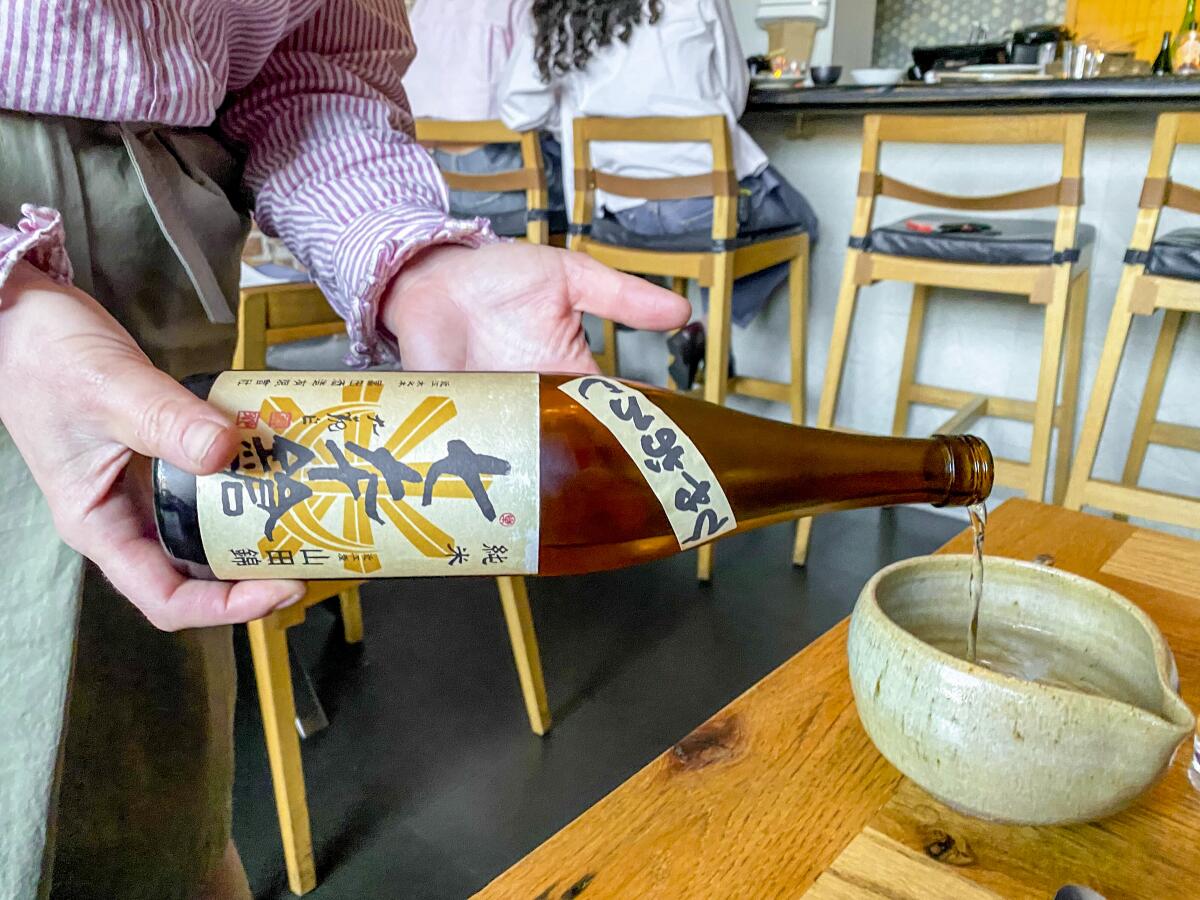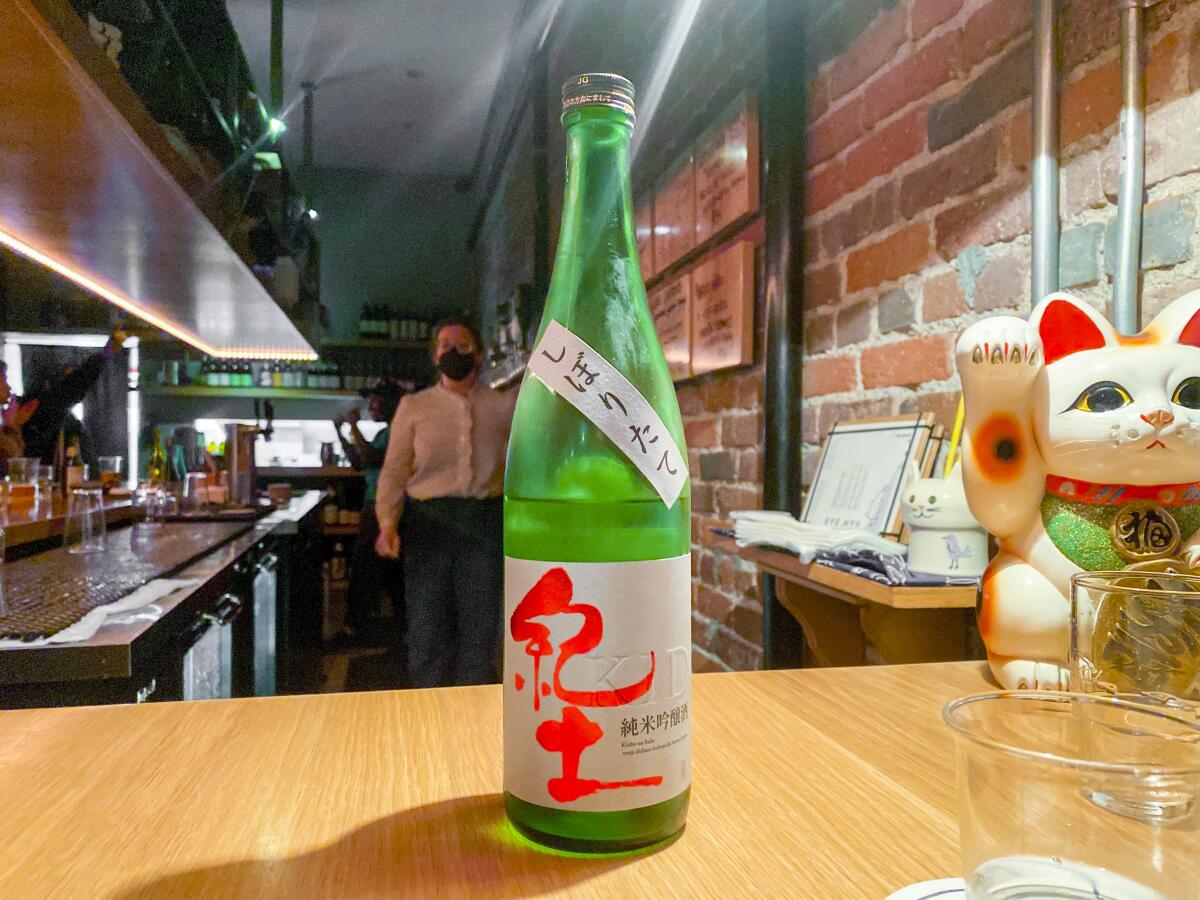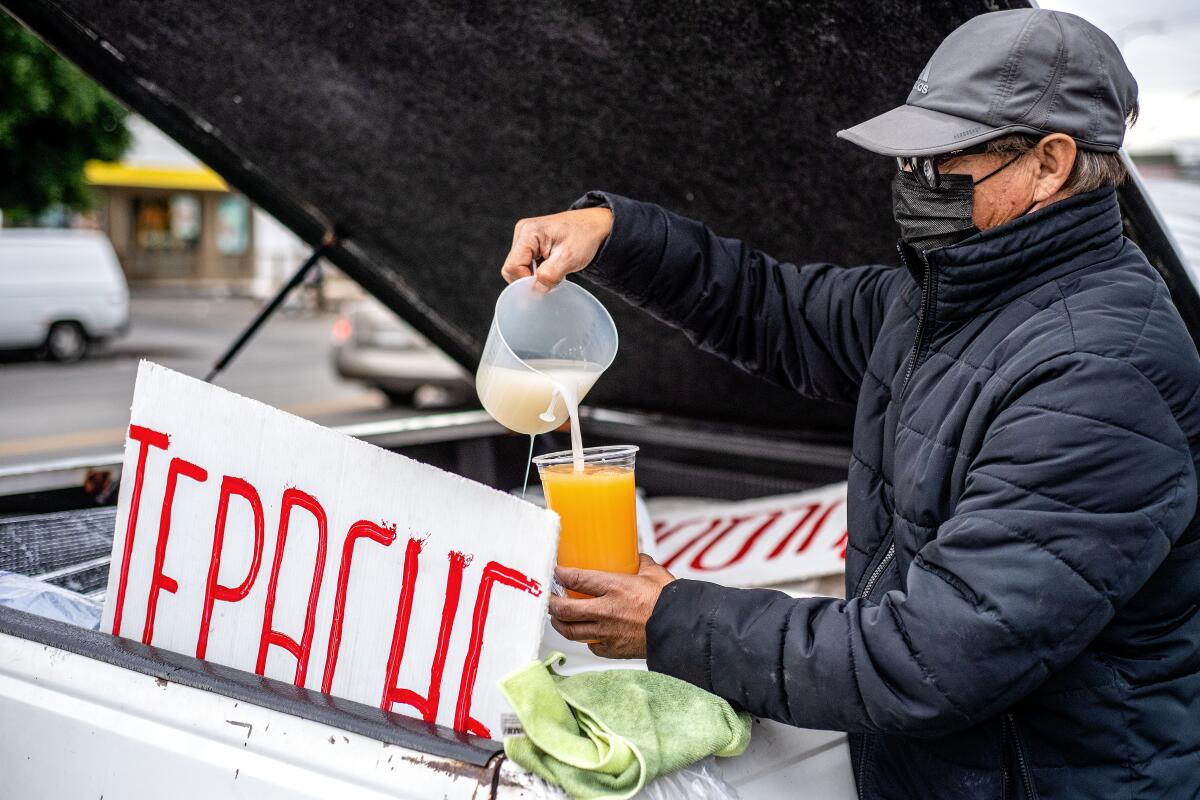A fresh reason why Ototo is L.A.’s best sake bar

- Share via
Ototo, the tiny but mighty sake bar owned by Courtney Kaplan and Charles Namba, opened in Echo Park in May 2019. I’d moved to the neighborhood the month before it launched and had embraced the place as my local watering hole. And, like so many other places, I grieved the loss of good conversations over its 11-seat bar less than a year later when the world stopped.
Six weeks ago — after nearly two years of takeout and delivery (which is still available), sudden closures and experiments with lunch service — Ototo resettled back into nightly operating hours. As before, it has a walk-in policy, and occasionally there are short waits to get inside. I’ve returned to bringing visiting friends there for a drink before dinner, even if that means walking the 39 feet to Tsubaki, its older-sibling izakaya, for sashimi, chawanmushi topped with frilly Dungeness crab and always a double order of chicken oysters. And more sake.
Enjoying this newsletter? Consider subscribing to the Los Angeles Times
Your support helps us deliver the news that matters most. Become a subscriber.
Kaplan has been immersing herself in the subject of sake since the late 1990s, when she returned to the United States after a year of study in Japan. She wanted to keep up the language, so she landed a job at Shuji Bon Yagi’s legendary sake bar Decibel in Manhattan. She and Namba met in New York, and when they moved to his native Los Angeles, she worked first as a sommelier at places like Bestia before the couple opened Tsubaki in the truest spirit of an izakaya; the experience is as much about Namba’s deft cooking as it is about Kaplan’s sake curations (as well as a succinct roster of geeky French wines).
If there’s a deeper list of sakes than the one at Ototo available on the West Coast, I don’t know of it. Kaplan has a gift for dividing them into categories that make an open-minded drinker eager to try new things. She gives expected distinctions between gradations of rice polish (Ginjo, Junmai Ginjo, Daiginjo). She also creates fun headings like “fruits and flowers,” “earth and umami,” “rice and minerals” and “delicious weirdos,” with descriptions (“toasted rice and savory nuts, with a squeeze of lemon and even a little Comte cheese”) that reel you in.
With all my ardor for Ototo and Tsubaki, it was only early this week that I realized I’d ignored an entire grouping of sakes on their lists for three years: “seasonal and nama.”
Eat your way across L.A.
Get our weekly Tasting Notes newsletter for reviews, news and more.
You may occasionally receive promotional content from the Los Angeles Times.
Maybe “seasonal” has become such a California cliché (however genuinely miraculous our agricultural abundance is) that I glossed right over it? Maybe daylight saving time and the impending calendar shift to springtime this weekend made the word leap out? Whatever the case, Kaplan was happy to help enlighten me.
The annual cycle for sake brewers traditionally begins in the fall, she told me, when varieties of the rice grown specifically for sake are harvested. Most sakes are pasteurized twice as part of the brewing process. “Nama” (the word translates as “raw” or “fresh”) are sakes that have gone through one or no pasteurization, and have to be shipped and stored refrigerated so they don’t spoil. Not all seasonal sakes are nama, but most are.
“The fact that sake is seasonal is something that’s lost on a lot of consumers in the U.S.,” Kaplan said. “In Japan, it’s a big deal when the first sakes of the year come out, and people may reserve their own bottles at the local liquor store. The pleasure is in trying something that drinks like it’s fresh from the brewing tank, as young and fresh as you can taste.”
Springtime sake releases tend to embody the return-to-life spirit of the moment: They’re bright, light, energetic. Kaplan uses the word “spritzy” to describe a nama on the menu from the Heiwa Shuzo brewery in the temperate Wakayama prefecture; it’s the right thing to kick off an evening when the temperatures still veer chilly as the sun sets.

Kaplan says this easy-going-down style of sake has a second level of appeal. “Very established breweries are putting younger people in the role of master brewer to craft sakes that will appeal to a younger generation. Wine is huge in Japan, and sake consumption is declining. So sake makers are looking at all these young people going to wine bars and trying to pick out the aspects of drinking wine that are appealing, and asking themselves how they can incorporate it into the profile of their sakes.”
Seasonal sakes aren’t all citrus and florals. The one that made the eyes at our group of three grow widest was the Ohyama “tomizu” nama, made from an old recipe in which the same proportions of water and rice are used during the brewing process. A halo of rich, savory flavors surrounds the palate with each sip. Kaplan uses the word “chewy” in her description. It paired magnificently with yakitori. Then Kaplan steered us toward Tae no Hana, a crossroads of freshness and umami made by Rumiko Moriki, who is the fourth generation of her family to run the Moriki brewery and was the first female toji (master sake brewer) in Japan.
These are the cyclical sakes that fit my mood this season — nuanced brews for complex times. Ototo: 1360 Allison Ave., Los Angeles, (213) 784-7930, ototo.la
Have a question?
Other stories
— Jenn Harris has the story on Mr. Charlie’s, the restaurant on La Brea Avenue that TikTokers are dubbing the “vegan McDonald’s. (And yes, she tried “The Unhappie Meal.”)
— Daniel Hernandez seeks out L.A. vendors selling the best versions of three delicious and quintessential Mexican fermented drinks: tejuino, tepache and pulque.
— The group behind Tao has a new Italian restaurant — and more of the news this week from Stephanie Breijo.
— This week I review Yangban Society, the new Korean American deli/restaurant in the Arts District. Serving brilliant creations like a congee pot pie, a riff on chili cheese fries made with black bean sauce-laced bolognese and so many beautiful vegetable dishes, chefs Katianna and John Hong are top-tier talents. Put it on your list if you haven’t been yet.

Eat your way across L.A.
Get our weekly Tasting Notes newsletter for reviews, news and more.
You may occasionally receive promotional content from the Los Angeles Times.



